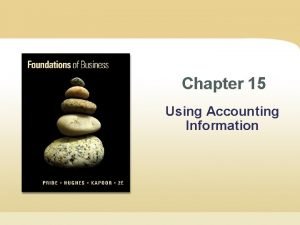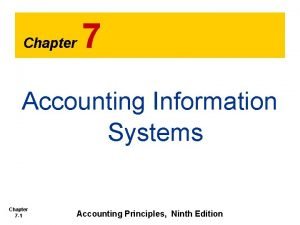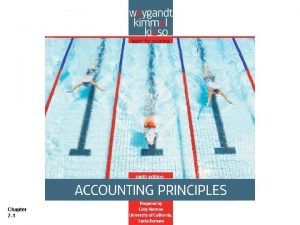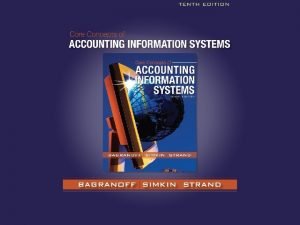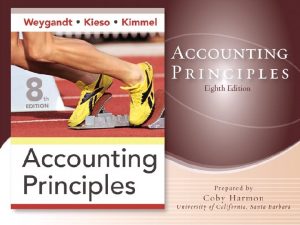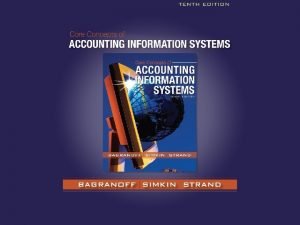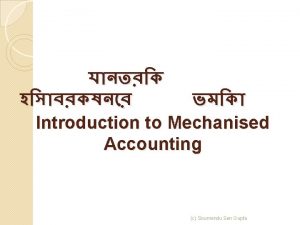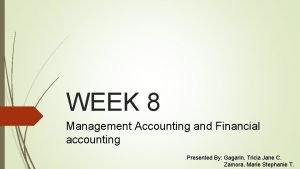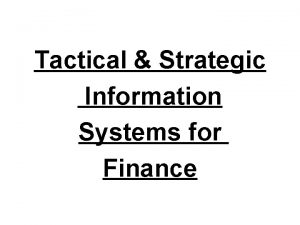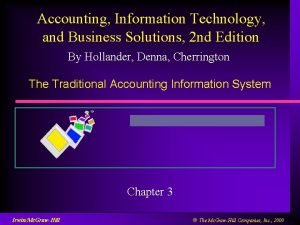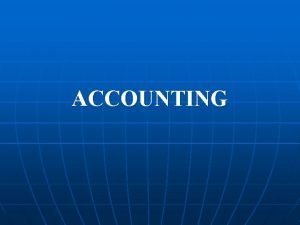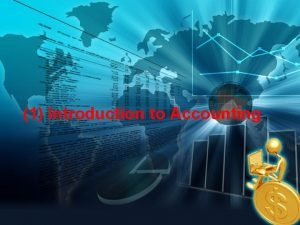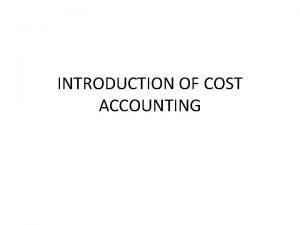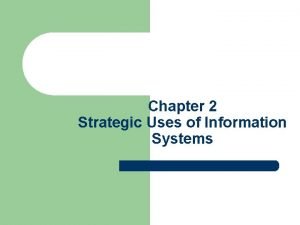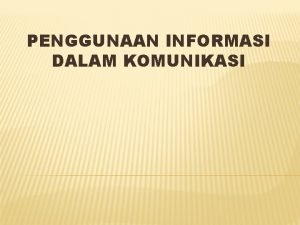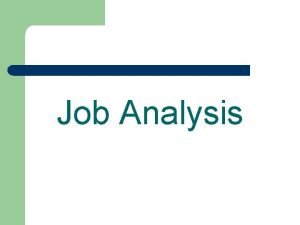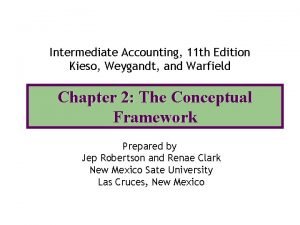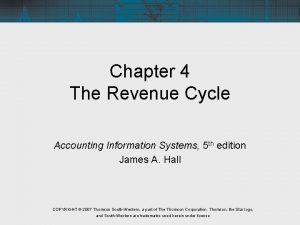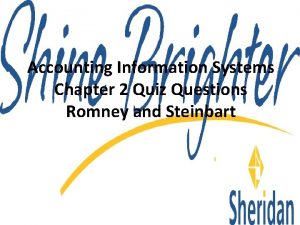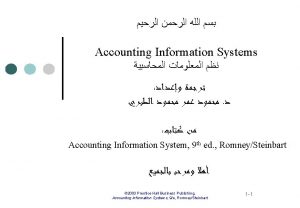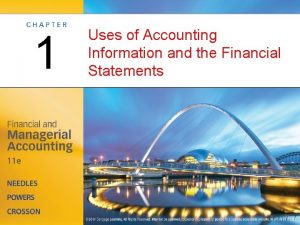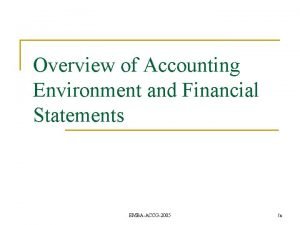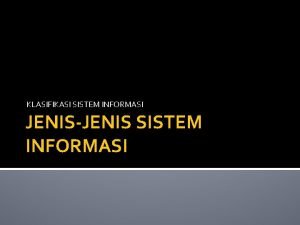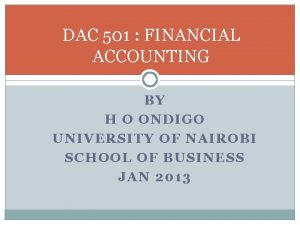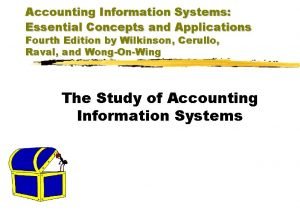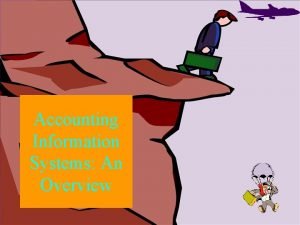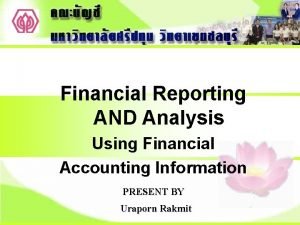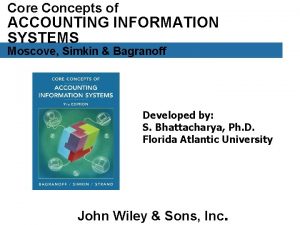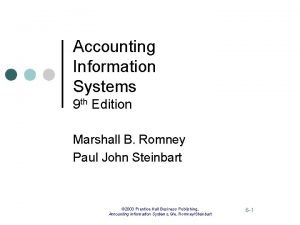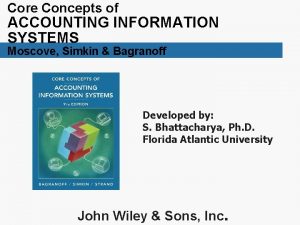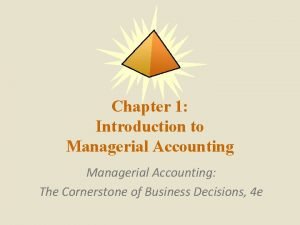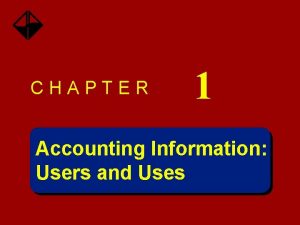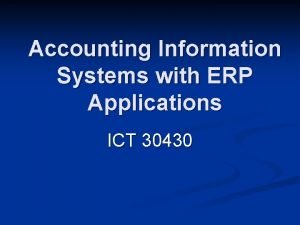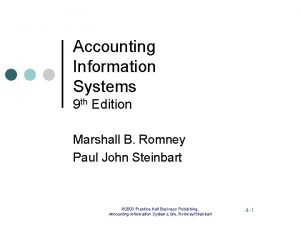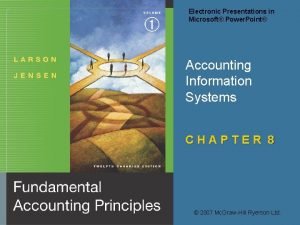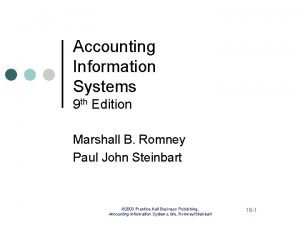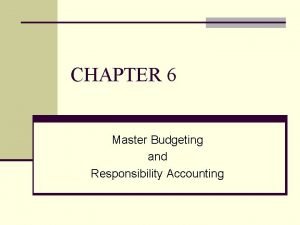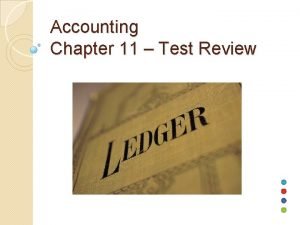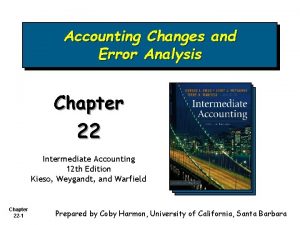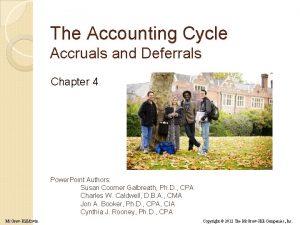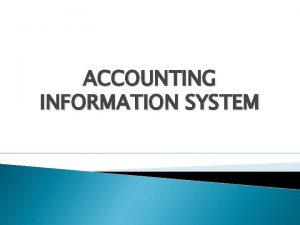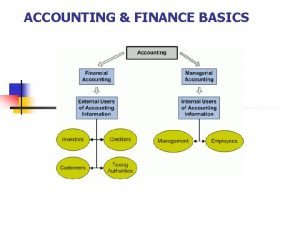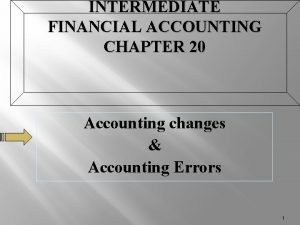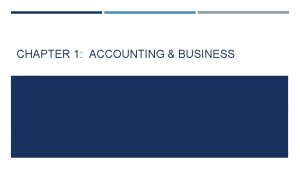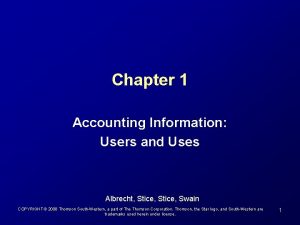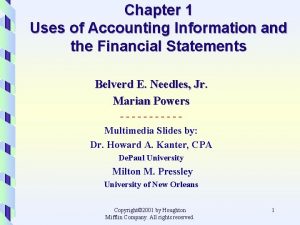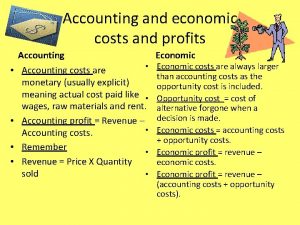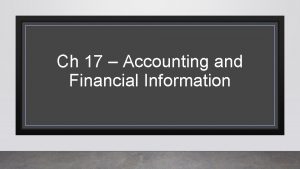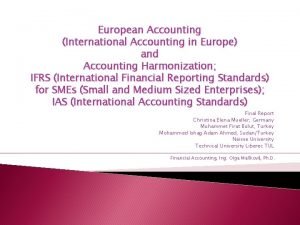Chapter 1 Uses of Accounting Information and the






























































































- Slides: 94

Chapter 1 Uses of Accounting Information and the Financial Statements Multimedia Slides by: Gail A. Mestas, MAcc, New Mexico State University

Learning Objectives 1. Define accounting, identify business goals and activities, and describe the role of accounting in making informed decisions. 2. Identify the many users of accounting information in society. 3. Explain the importance of business transactions, money measure, and separate entity to accounting measurement. 4. Identify the three basic forms of business organization. Copyright © Houghton Mifflin Company. All rights reserved. 2

Learning Objectives (cont’d) 5. Define financial position, state the accounting equation, and show they are affected by simple transactions. 6. Identify the four financial statements. 7. State the relationship of generally accepted accounting principles (GAAP) to financial statements and the independent CPA’s report, and identify the organizations that influence GAAP. 8. Define ethics and describe the ethical responsibilities of accountants. Copyright © Houghton Mifflin Company. All rights reserved. 3

Accounting as an Information System • Objective 1 – Define accounting, identify business goals and activities, and describe the role of accounting in making informed decisions Copyright © Houghton Mifflin Company. All rights reserved. 4

Accounting … is an information system that measures processes communicates financial information about an identifiable, economic entity Copyright © Houghton Mifflin Company. All rights reserved. 5

Accounting …supplies the information decision makers need to make reasoned choices among alternative uses of scarce resources in the conduct of business and economic activities Copyright © Houghton Mifflin Company. All rights reserved. 6

Accounting … • Is a link between business activities and decision makers – Decision makers use accounting information to make informed decisions about available alternatives • Measures business activities by recording data about them for future use • Is communicated to decision makers through reports Copyright © Houghton Mifflin Company. All rights reserved. 7

Accounting as an Information System Input Output Accounting System Copyright © Houghton Mifflin Company. All rights reserved. 8

Business Goals, Activities, and Performance Measures • Business – An economic unit that aims to sell goods and services to customers at prices that will provide an adequate return to its owners Copyright © Houghton Mifflin Company. All rights reserved. 9

Business Goals • Profitability – The ability to earn enough income to attract and hold investment capital • Liquidity – Having enough cash available to pay debts when they are due Copyright © Houghton Mifflin Company. All rights reserved. 10

Business Activities • Financing Activities • Investing Activities • Operating Activities Copyright © Houghton Mifflin Company. All rights reserved. 11

Financing Activities • Activities associated with obtaining adequate funds, or capital, to begin and continue operations – Owner investments – Paying a return to owners – Obtaining loans from creditors – Repaying amounts to creditors, plus interest Copyright © Houghton Mifflin Company. All rights reserved. 12

Investing Activities • Activities associated with spending funds to begin and continue operations – Buying resources such as land, buildings, and equipment needed in the operation of the business – Selling these resources when no longer needed Copyright © Houghton Mifflin Company. All rights reserved. 13

Operating Activities • Activities associated with the course of running a business – Selling goods and services – Employing managers and workers – Buying goods and services – Paying taxes Copyright © Houghton Mifflin Company. All rights reserved. 14

Performance Measures • Indicators – Used to determine whether 1. Managers are achieving their business goals 2. Business activities are well managed • Include – – Earned income Cash flow Ratio of expenses to revenue Ratio of money owed to total resources controlled Copyright © Houghton Mifflin Company. All rights reserved. 15

Financial and Management Accounting • Accounting’s role is divided into two categories 1. Management accounting 2. Financial accounting • The functions of both categories overlap • Primary difference between the two is the principal users of the information Copyright © Houghton Mifflin Company. All rights reserved. 16

Management Accounting • Focuses on internal decision makers – Managers and employees • Reporting format is flexible and based on the type of information needed, such as budgets and sales forecasts • Used to report past performance and expected future performance Copyright © Houghton Mifflin Company. All rights reserved. 17

Financial Accounting • Focuses on external decision makers – Stockholders – Banks and other creditors – Government regulators • Financial information of company is reported in the financial statements – Used to report directly on goals of profitability and liquidity Copyright © Houghton Mifflin Company. All rights reserved. 18

Bookkeeping versus Accounting Bookkeeping – Repetitive, mechanical process of recording financial transactions and keeping financial records Copyright © Houghton Mifflin Company. All rights reserved. Accounting – Bookkeeping a small part of accounting – Includes design of an information system to meet users’ needs – Goals include the analysis, interpretation, and use of information 19

Processing Accounting Information Ways in which accounting information is processed: Bookkeeping Computer Management information system (MIS) MIS – Provides information needed to run a business – Consists of interconnected subsystems – Most important subsystem is the accounting information system Copyright © Houghton Mifflin Company. All rights reserved. 20

Discussion Q. What is the difference between profitability and liquidity? A. Profitability • Earning enough income (revenues minus expenses) to attract and hold investors Liquidity • Having enough funds available (cash) to pay debts when they are due Copyright © Houghton Mifflin Company. All rights reserved. 21

Decision Makers: The Users of Accounting Information • Objective 2 – Identify the many users of accounting information in society Copyright © Houghton Mifflin Company. All rights reserved. 22

Decision Makers … fall into three categories 1. Those who manage a business – – – – Finance Investment Operations and Production Marketing Human Resources Information Systems Accounting Copyright © Houghton Mifflin Company. All rights reserved. 23

Decision Makers (cont’d) 2. Those with a Direct Financial Interest – Investors – Creditors 3. Those with an Indirect Financial Interest – – – Tax Authorities Regulatory Agencies Labor Unions Financial Advisors Customers Economic Planners Copyright © Houghton Mifflin Company. All rights reserved. 24

Management • Managers are internal users of accounting information – Make key decisions using accounting information – Basic management functions require accounting information for decision making • • • Financing the business Investing resources Producing goods and services Marketing goods and services Managing employees Providing information to decision makers Copyright © Houghton Mifflin Company. All rights reserved. 25

Users With a Direct Financial Interest … are external users of accounting information • Investors – Put money into a business in order to make money (by purchasing and selling stocks and receiving dividends) – Use financial statements to judge the prospects for profitable investments Copyright © Houghton Mifflin Company. All rights reserved. 26

Users With a Direct Financial Interest (cont’d) • Creditors – Loan money to a business in order to make money (by charging interest) – Use financial statements to judge whether a company will have enough cash to • Pay interest charges • Repay debt at appropriate time Copyright © Houghton Mifflin Company. All rights reserved. 27

Users With an Indirect Financial Interest … are external users of accounting information • Tax authorities – Use accounting information to determine amount of tax due – Procedures for tax reporting mandated by law • Government regulatory agencies – Federal, state, and local levels – Securities and Exchange Commission (SEC) • Regulates the issuing, buying, and selling of stocks in the U. S. Copyright © Houghton Mifflin Company. All rights reserved. 28

Users With an Indirect Financial Interest (cont’d) • Other groups – Labor unions – Those advising investors and creditors • Financial analysts and advisors • Brokers • Underwriters • Lawyers • Financial press – Consumer groups – Customers – General public – Economic planners Copyright © Houghton Mifflin Company. All rights reserved. 29

Government and Not-for-Profit Organizations • Include – – Hospitals Universities Professional organizations Charities • Have the same categories of decision makers as profit-oriented organizations – Managers – Those with a direct financial interest – Those with an indirect financial interest Copyright © Houghton Mifflin Company. All rights reserved. 30

Discussion Q. How do management accounting and financial accounting differ? A. Management Accounting –Focus on internal users –All types of information –Communicated in format most suitable to purpose Financial Accounting –Focus on external users as well as internal users –Specific information –Communicated in financial statements Copyright © Houghton Mifflin Company. All rights reserved. 31

Accounting Measurement • Objective 3 – Explain the importance of business transactions, money measure, and separate entity to accounting measurement Copyright © Houghton Mifflin Company. All rights reserved. 32

Accounting Measurement Four Basic Questions 1. What is measured? • Business transactions affecting the financial position of the business entity 2. When should the measurement be made? • Discussed in Chapter 2, The Recognition Issue Copyright © Houghton Mifflin Company. All rights reserved. 33

Accounting Measurement (cont’d) 3. What value should be placed on what is measured? • Discussed in Chapter 2, The Valuation Issue 4. How should what is measured be classified? • Discussed in Chapter 2, The Classification Issue Copyright © Houghton Mifflin Company. All rights reserved. 34

Business Transactions … are economic events that affect the financial position of a business entity – Involve an exchange of value • • Purchase Sale Payment Collection – Events that have the same effect as an exchange of value • Loss from fire, flood, theft • Physical wear and tear on equipment • Accumulation of interest Copyright © Houghton Mifflin Company. All rights reserved. 35

Money Measure • Recording of all business transactions in terms of money • Money is the only factor common to all business transactions • Basic unit of money determined by the country in which business resides • Exchange rates are used to translate transactions from one currency to another Copyright © Houghton Mifflin Company. All rights reserved. 36

Money Measure (cont’d) • Exchange Rate – The value of one currency in terms of another – Changes daily • Example: – Assume the price of one British pound is 1. 61 U. S. dollars. How many British pounds would one U. S. dollar buy? 1 British pound ÷ 1. 61 U. S. dollars = 0. 62 British pounds per U. S. dollar Copyright © Houghton Mifflin Company. All rights reserved. 37

Separate Entity • A business is distinct from its – Owner(s) – Creditors – Customers • Its financial records and reports should refer only to its own financial affairs Copyright © Houghton Mifflin Company. All rights reserved. 38

Discussion Q. Identify each of the following as most closely related to a a) business transaction, b) separate entity, or c) money measure (b) 1. Partnership (c) 2. (a) 3. (b) 4. (a) 5. Copyright © Houghton Mifflin Company. All rights reserved. U. S. dollar Payment of an expense Corporation Sale of an asset 39

Forms of Business Organization • Objective 4 – Identify the three basic forms of business organization Copyright © Houghton Mifflin Company. All rights reserved. 40

Forms of Business Enterprises • Three basic forms of business enterprises – Sole proprietorship – Partnership – Corporation Copyright © Houghton Mifflin Company. All rights reserved. 41

Separate Entities • All three forms of businesses are economically separate entities from their owners – Financial records and reports refer to the financial affairs of the business only • Only the corporation is a legally separate entity from its owners Copyright © Houghton Mifflin Company. All rights reserved. 42

Sole Proprietorships • Business owned by one person – The owner • Receives all profits or losses • Is liable for all obligations of the business • Not incorporated • Life of business ends when the owner – Decides to stop operating business – Dies – Is incapacitated Copyright © Houghton Mifflin Company. All rights reserved. 43

Partnerships • Business owned by more than one person – The partners share all profits or losses according to an agreed upon formula – At least one partner is liable for all obligations of the business • Not incorporated • Life of business ends when – Ownership changes • A partner leaves the business or dies • A new partner is admitted Copyright © Houghton Mifflin Company. All rights reserved. 44

The Corporation as a Separate Entity • Legally and economically separate from its owners – Business unit chartered by the state and legally separate from owners (incorporated) – Owners (stockholders) do not directly control operations – Elected board of directors run the corporation – Owners’ risk of loss limited to amount paid for shares of stock – owners are not liable for the obligations of the business Copyright © Houghton Mifflin Company. All rights reserved. 45

Sole Proprietorships and Partnerships versus Corporations Sole Proprietorships and Partnerships Corporations • Separate economic entity • Not separate legal entity • Separate legal entity • Owner(s) directly control operations • Owner do not directly control operations – elected board of directors runs corporation • No economic separation between owner(s) and the business – owners liable for obligations of the business • Owner’s risk of loss (liability) limited to amount paid for shares of stock • Ownership cannot be transferred • Ownership can be transferred • Life of business is limited • Life of business is unlimited Copyright © Houghton Mifflin Company. All rights reserved. 46

Discussion Q. How do a sole proprietorship, partnership, and corporation differ? A. B. Sole proprietorship One owner – OOwner legally obligated to pay company liabilities Partnership – – MMultiple owners (partners) PPartners legally obligated to pay company liabilities Corporation – – OOwned by stockholders SStockholders not legally obligated to pay company liabilities Copyright © Houghton Mifflin Company. All rights reserved. 47

Financial Position and the Accounting Equation • Objective 5 – Define financial position, state the accounting equation, and show they are affected by simple transactions Copyright © Houghton Mifflin Company. All rights reserved. 48

Financial Position The economic resources that belong to a company and the claims against those resources at a point in time Economic Resources = Equities Copyright © Houghton Mifflin Company. All rights reserved. 49

Developing the Accounting Equation Economic Resources = Equities Two types of equities Creditor’s equities and owner's equities, therefore, Assets = Creditor’s Liabilities. Equities Economic Resources + Owner’s Equities In accounting terminology Economic resources are called assets Creditor’s equities are called liabilities Copyright © Houghton Mifflin Company. All rights reserved. 50

Accounting Equation Assets = Liabilities + Owner’s Equity Two sides of equation are always in balance • Assets – Economic resources owned by a company that are expected to benefit future operations • Liabilities – Obligations of a business to pay cash, transfer assets, or provide services to other entities in the future – Represent claims of creditors to the assets of the business • Owner’s Equity – Represents the claims by owners to the assets of the business Copyright © Houghton Mifflin Company. All rights reserved. 51

Owner’s Equity • Equals the residual interest in a company’s assets after deducting all liabilities • Also called residual equity or net assets • Defined by rearranging the accounting equation Assets = Liabilities + Owner’s Equity = Assets – Liabilities Copyright © Houghton Mifflin Company. All rights reserved. 52

Transactions That Affect Owner’s Equity • Owner’s investments – Assets the owner puts into the business • Owner’s withdrawals – Assets the owner takes out of the business • Revenues – Increases in owner’s equity that result from operating a business • Expenses – Decreases in owner’s equity that result from operating a business Copyright © Houghton Mifflin Company. All rights reserved. 53

Illustrative Transactions for Shannon Realty Effects of Transactions on the Accounting Equation Copyright © Houghton Mifflin Company. All rights reserved. 54

Owner’s Investments 1. Deposited $50, 000 in a bank account in the name of Shannon Realty John Shannon, Capital +$50, 000 Cash 1. +$50, 000 A = $50, 000 L + OE = $50, 000 Notice that the accounting equation Assets = Liabilities + Owner's Equity, or A = L + OE, is always in balance Copyright © Houghton Mifflin Company. All rights reserved. 55

Purchase of Assets with Cash 2. Purchased a lot for $10, 000 and a small building on a lot for $25, 000 Cash 1. $50, 000 2. -35, 000 bal. $15, 000 Land John Shannon, Capital $50, 000 Building + $10, 000 +$25, 000 $10, 000 $25, 000 A = $50, 000 L + OE = $50, 000 This transaction only affects one side of the accounting equation – Assets Whenever a transaction affects only one side of the accounting equation, the total on each side of the equal sign remains unchanged Copyright © Houghton Mifflin Company. All rights reserved. 56

Purchase of Assets by Incurring a Liability 3. Purchased office supplies for $500 on credit Cash 1. $50, 000 2. -35, 000 3. bal. $15, 000 Supplies +$500 Land Building $10, 000 $25, 000 $10, 000 A = $50, 500 Copyright © Houghton Mifflin Company. All rights reserved. $25, 000 A/P +$500 John Shannon, Capital $50, 000 L + OE = $50, 500 57

Payment of a Liability 4. Paid $200 of the $500 owed for supplies Cash 1. $50, 000 2. -35, 000 3. 4. -200 Supplies bal. $14, 800 $500 Land Building $10, 000 $25, 000 $500 A/P John Shannon, Capital $50, 000 $500 -200 $10, 000 A = $50, 300 Copyright © Houghton Mifflin Company. All rights reserved. $25, 000 $300 $50, 000 L + OE = $50, 300 58

Revenues 5. Earned and received a commission of $1, 500 in cash Cash 1. $50, 000 2. -35, 000 3. 4. -200 5. +1, 500 Supplies bal. $16, 300 $500 Land Building $10, 000 $25, 000 $500 A/P John Shannon, Capital $50, 000 $500 -200 +1, 500 $10, 000 A = $51, 800 Copyright © Houghton Mifflin Company. All rights reserved. $25, 000 $300 $51, 500 L + OE = $51, 800 59

Revenues 6. Earned a commission of $2, 000 to be received at a later date Cash A/R 1. $50, 000 2. -35, 000 3. 4. -200 5. 1, 500 6. +$2, 000 bal. $16, 300 $2, 000 Supplies Land Building $10, 000 $25, 000 $500 A/P John Shannon, Capital $50, 000 $500 -200 1, 500 +2, 000 $500 $10, 000 A = $53, 800 Copyright © Houghton Mifflin Company. All rights reserved. $25, 000 $300 $53, 500 L + OE = $53, 800 60

Collection of Accounts Receivable 7. Received $1, 000 from client for commission earned earlier in the month Cash 1. $50, 000 2. -35, 000 3. 4. -200 5. 1, 500 6. 7. +1, 000 $2, 000 -1, 000 bal. $17, 300 $1, 000 Supplies A/R Land Building $10, 000 $25, 000 $500 A/P John Shannon, Capital $50, 000 $500 -200 1, 500 2, 000 $500 $10, 000 A = $53, 800 Copyright © Houghton Mifflin Company. All rights reserved. $25, 000 $300 $53, 500 L + OE = $53, 800 61

Expenses 8. Paid $1, 000 to rent equipment for office Cash 1. $50, 000 2. -35, 000 3. 4. -200 5. 1, 500 6. 7. 1, 000 8. -1, 000 bal. $16, 300 Supplies A/R Land Building $10, 000 $25, 000 $500 A/P John Shannon, Capital $50, 000 $500 -200 1, 500 2, 000 $2, 000 -1, 000 $1, 000 $500 $10, 000 A = $52, 800 Copyright © Houghton Mifflin Company. All rights reserved. $25, 000 $300 $52, 500 L + OE = $52, 800 62

Expenses 9. Paid $400 in wages to part-time helper Cash 1. $50, 000 2. -35, 000 3. 4. -200 5. 1, 500 6. 7. 1, 000 8. -1, 000 9. -400 bal. $15, 900 Supplies A/R Land Building $10, 000 $25, 000 $500 A/P John Shannon, Capital $50, 000 $500 -200 1, 500 2, 000 $2, 000 -1, 000 -400 $1, 000 $500 $10, 000 A = $52, 400 Copyright © Houghton Mifflin Company. All rights reserved. $25, 000 $300 $52, 100 L + OE = $52, 400 63

Expenses 10. Recorded utilities expense of $500 incurred in December but not yet paid Cash 1. $50, 000 2. -35, 000 3. 4. -200 5. 1, 500 6. 7. 1, 000 8. -1, 000 9. -400 10. bal. $15, 900 Supplies A/R Land Building $10, 000 $25, 000 $500 A/P $500 -200 1, 500 2, 000 $2, 000 -1, 000 $1, 000 John Shannon, Capital $50, 000 $500 $10, 000 A = $52, 400 Copyright © Houghton Mifflin Company. All rights reserved. $25, 000 +300 -1, 000 -400 -300 $600 $51, 800 L + OE = $52, 400 64

Owner’s Withdrawals 11. Withdrew $600 in cash from Shannon Realty and deposited it in a personal account Cash 1. $50, 000 2. -35, 000 3. 4. -200 5. 1, 500 6. 7. 1, 000 8. -1, 000 9. -400 10. 11. -600 bal. $15, 300 Supplies A/R Land Building $10, 000 $25, 000 $500 A/P $500 -200 1, 500 2, 000 $2, 000 -1, 000 300 $1, 000 John Shannon, Capital $50, 000 $500 $10, 000 A = $51, 800 Copyright © Houghton Mifflin Company. All rights reserved. $25, 000 $600 -1, 000 -400 -300 -600 $51, 200 L + OE = $51, 800 65

Discussion Q. What does the accounting equation represent? A. The economic resources owned by a company and the claims against those resources at a point in time Assets = Liabilities + Owner’s Equity Copyright © Houghton Mifflin Company. All rights reserved. 66

Communications Through Financial Statements • Objective 6 – Identify the four financial statements Copyright © Houghton Mifflin Company. All rights reserved. 67

Communications Through Financial Statements • Four Major Financial Statements – Income Statement – Statement of Owner’s Equity – Balance Sheet – Statement of Cash Flows Copyright © Houghton Mifflin Company. All rights reserved. 68

Income Statement • Summarizes revenues earned and expenses incurred over a period of time • Dated “For the Month Ended …” • Purpose to measure a company’s performance over a period of time • Shows whether or not a company achieved its profitability goal Copyright © Houghton Mifflin Company. All rights reserved. 69

Income Statement (cont’d) • Considered by many to be most important financial statement • Also called the capital statement • First financial statement to be prepared in a sequence • Net income figure used to prepare statement of owner’s equity Copyright © Houghton Mifflin Company. All rights reserved. 70

Income Statement Date reflects revenues and expenses incurred over a period of time Net income figure used to prepare statement of owner’s equity Copyright © Houghton Mifflin Company. All rights reserved. 71

Statement of Owner’s Equity • Shows changes in owner’s equity over a period of time • Dated “For the Month Ended …” • Uses net income figure from income statement • End of period balance in Capital account used to prepare balance sheet Copyright © Houghton Mifflin Company. All rights reserved. 72

Statement of Owner’s Equity Date reflects changes in John Shannon, Capital, over a period of time Ending balance of John Shannon, Capital, used to prepare the balance sheet Copyright © Houghton Mifflin Company. All rights reserved. Net income figure from income statement 73

Balance Sheet • Shows the financial position of a company on a certain date • Dated as of a certain date • Also called the statement of financial position • Presents view of business as holder of assets that are equal to the claims against those assets • Claims consist of liabilities and owner’s equity Copyright © Houghton Mifflin Company. All rights reserved. 74

Balance Sheet Balance in Cash account used in statement of cash flows Copyright © Houghton Mifflin Company. All rights reserved. Date reflects account balances as of a certain date John Shannon, Capital, from statement of owner’s equity 75

Statement of Cash Flows • Shows cash flows into and out of a business over a period of time • Dated “For the Month Ended …” • Focuses on whether the business met its liquidity goal • Explains how the Cash account changed during the period Copyright © Houghton Mifflin Company. All rights reserved. 76

Statement of Cash Flows Date reflects cash flows over a period of time Begins with net income from income statement Cash at end of month same as Cash account balance on balance sheet Copyright © Houghton Mifflin Company. All rights reserved. 77

Discussion Q. The balance sheet is often referred to as the statement of financial position. What does financial position mean? A. Financial position is the resources, or assets, owned by a business as of a certain date These resources are offset by claims against them and stockholders’ equity, as shown on the balance sheet Copyright © Houghton Mifflin Company. All rights reserved. 78

Generally Accepted Accounting Principles • Objective 7 – State the relationship of generally accepted accounting principles (GAAP) to financial statements and the independent CPA’s report, and identify the organizations that influence GAAP Copyright © Houghton Mifflin Company. All rights reserved. 79

Generally Accepted Accounting Principles (GAAP) • The conventions, rules, and procedures necessary to define accounting practice at a particular time • Developed to provide guidelines for financial accounting • Are altered as better methods evolve or circumstances change Copyright © Houghton Mifflin Company. All rights reserved. 80

Financial Statements, GAAP, and the Independent CPA’s Report (Audit) Financial Statements Audit • Summary of financial affairs of a business • Examination of a company's financial statements • Prepared by management of company • Prepared by independent certified public accountant (CPA) • Management has an interest in company performance; not independent • CPA should have no compromising ties with company • Should be prepared in accordance with GAAP • Ascertains that financial statements prepared in accordance with GAAP • Implies that investors and creditors can rely on financial statements Copyright © Houghton Mifflin Company. All rights reserved. 81

Organizations That Influence Current Practice • Financial Accounting Standards Board (FASB) – Most important body for developing and issuing rules on accounting practice – Issues Statements of Financial Accounting Standards (SFAS) • American Institute of Certified Public Accountants (AICPA) – Professional association of certified public accountants – Influences accounting practice through activities of senior technical committees Copyright © Houghton Mifflin Company. All rights reserved. 82

Organizations That Influence Current Practice (cont’d) • Securities and Exchange Commission (SEC) – Federal agency set up to protect the public by regulating the issuing, buying, and selling of stocks and bonds – Has legal power to set and enforce accounting policies for companies whose securities are offered for sale to the general public • Government Accounting Standards Board (GASB) – Established under same governing body as Financial Accounting Standards Board (FASB) – Responsible for issuing accounting standards for state and local governments Copyright © Houghton Mifflin Company. All rights reserved. 83

Organizations That Influence Current Practice (cont’d) • International Accounting Standards Board (IASB) – An independent board, cooperating with national accounting standard setters, to develop high quality, understandable, and enforceable global accounting standards – Has published over 30 standards in a series of pronouncements called International Financial Reporting Standards (IFRS) • Internal Revenue Service (IRS) – Branch of the Department of Treasury – Administers the Internal Revenue Code enacted by Congress – Interprets and enforces U. S. tax laws governing the assessment and collection of revenues from income taxes Copyright © Houghton Mifflin Company. All rights reserved. 84

Discussion Q. What are GAAP? A. Generally accepted accounting principles The conventions, rules, and procedures necessary to define accounting practice at a particular time Q. What organization has the greatest influence on GAAP? A. Financial Accounting Standards Board (FASB) Copyright © Houghton Mifflin Company. All rights reserved. 85

Professional Ethics and the Accounting Profession • Objective 8 – Define ethics and describe the ethical responsibilities of accountants Copyright © Houghton Mifflin Company. All rights reserved. 86

Ethics … is the code of conduct that applies to everyday life • Addresses whether actions are right or wrong • Ethical actions are the product of individual decisions • Certain actions may be unethical but not illegal Copyright © Houghton Mifflin Company. All rights reserved. 87

Professional Ethics … is the code of conduct that applies to the practice of a profession • Accountants have a responsibility to their employers, clients, and society to uphold highest ethical standards • AICPA and each state have adopted codes of professional conduct for certified public accountants Copyright © Houghton Mifflin Company. All rights reserved. 88

Ethical Principles • Integrity – Requires honesty, frankness, and placing service and public trust before personal gain • Objectivity – Requires impartiality and intellectual honesty • Independence – Requires that an accountant avoid all relationships that impair, or appear to impair, his or her objectivity Copyright © Houghton Mifflin Company. All rights reserved. 89

Ethical Principles (cont’d) • Due care – Accountants required to carry out professional responsibilities competently and diligently Copyright © Houghton Mifflin Company. All rights reserved. 90

Institute of Management Accountants (IMA) • Code of Professional Conduct for Management Accountants – Emphasizes: • Competence • Confidentiality • Integrity • Independence • Objectivity Copyright © Houghton Mifflin Company. All rights reserved. 91

Discussion Q. To whom do accountants have an ethical responsibility? A. Employers Clients Society Q. What does due care mean? A. The act of carrying out professional responsibilities with competence and diligence Copyright © Houghton Mifflin Company. All rights reserved. 92

Time for Review 1. Define accounting, identify business goals and activities, and describe the role of accounting in making informed decisions 2. Identify the many users of accounting information in society 3. Explain the importance of business transactions, money measure, and separate entity to accounting measurement 4. Identify the three basic forms of business organization Copyright © Houghton Mifflin Company. All rights reserved. 93

and Finally … 5. Define financial position, state the accounting equation, and show they are affected by simple transactions 6. Identify the four financial statements 7. State the relationship of generally accepted accounting principles (GAAP) to financial statements and the independent CPA’s report, and identify the organizations that influence GAAP 8. Define ethics and describe the ethical responsibilities of accountants Copyright © Houghton Mifflin Company. All rights reserved. 94
 Intermediate accounting chapter 1
Intermediate accounting chapter 1 Chapter 15 using management and accounting information
Chapter 15 using management and accounting information Chapter 7 accounting information systems
Chapter 7 accounting information systems Chapter 7 accounting information systems
Chapter 7 accounting information systems Dfd chapter 3
Dfd chapter 3 Accounting information system chapter 1
Accounting information system chapter 1 Chapter 7 accounting information systems
Chapter 7 accounting information systems Accounting information system chapter 1
Accounting information system chapter 1 Accounting information system chapter 1
Accounting information system chapter 1 Accounting information system chapter 1
Accounting information system chapter 1 What are the uses of mechanised accounting
What are the uses of mechanised accounting Hát kết hợp bộ gõ cơ thể
Hát kết hợp bộ gõ cơ thể Frameset trong html5
Frameset trong html5 Bổ thể
Bổ thể Tỉ lệ cơ thể trẻ em
Tỉ lệ cơ thể trẻ em Gấu đi như thế nào
Gấu đi như thế nào Thang điểm glasgow
Thang điểm glasgow Chúa yêu trần thế alleluia
Chúa yêu trần thế alleluia Môn thể thao bắt đầu bằng chữ f
Môn thể thao bắt đầu bằng chữ f Thế nào là hệ số cao nhất
Thế nào là hệ số cao nhất Các châu lục và đại dương trên thế giới
Các châu lục và đại dương trên thế giới Công thức tiính động năng
Công thức tiính động năng Trời xanh đây là của chúng ta thể thơ
Trời xanh đây là của chúng ta thể thơ Cách giải mật thư tọa độ
Cách giải mật thư tọa độ 101012 bằng
101012 bằng Phản ứng thế ankan
Phản ứng thế ankan Các châu lục và đại dương trên thế giới
Các châu lục và đại dương trên thế giới Thơ thất ngôn tứ tuyệt đường luật
Thơ thất ngôn tứ tuyệt đường luật Quá trình desamine hóa có thể tạo ra
Quá trình desamine hóa có thể tạo ra Một số thể thơ truyền thống
Một số thể thơ truyền thống Cái miệng xinh xinh thế chỉ nói điều hay thôi
Cái miệng xinh xinh thế chỉ nói điều hay thôi Vẽ hình chiếu vuông góc của vật thể sau
Vẽ hình chiếu vuông góc của vật thể sau Thế nào là sự mỏi cơ
Thế nào là sự mỏi cơ đặc điểm cơ thể của người tối cổ
đặc điểm cơ thể của người tối cổ Thế nào là giọng cùng tên? *
Thế nào là giọng cùng tên? * Vẽ hình chiếu đứng bằng cạnh của vật thể
Vẽ hình chiếu đứng bằng cạnh của vật thể Tia chieu sa te
Tia chieu sa te Thẻ vin
Thẻ vin đại từ thay thế
đại từ thay thế điện thế nghỉ
điện thế nghỉ Tư thế ngồi viết
Tư thế ngồi viết Diễn thế sinh thái là
Diễn thế sinh thái là Dot
Dot So nguyen to
So nguyen to Tư thế ngồi viết
Tư thế ngồi viết Lời thề hippocrates
Lời thề hippocrates Thiếu nhi thế giới liên hoan
Thiếu nhi thế giới liên hoan ưu thế lai là gì
ưu thế lai là gì Khi nào hổ mẹ dạy hổ con săn mồi
Khi nào hổ mẹ dạy hổ con săn mồi Khi nào hổ con có thể sống độc lập
Khi nào hổ con có thể sống độc lập Sơ đồ cơ thể người
Sơ đồ cơ thể người Từ ngữ thể hiện lòng nhân hậu
Từ ngữ thể hiện lòng nhân hậu Thế nào là mạng điện lắp đặt kiểu nổi
Thế nào là mạng điện lắp đặt kiểu nổi Internal users of accounting information
Internal users of accounting information What is tactical information system
What is tactical information system Accounting information technology and business solutions
Accounting information technology and business solutions Language
Language Internal users of financial reports
Internal users of financial reports Management accounting system
Management accounting system Advantages of computerized accounting system
Advantages of computerized accounting system Materiality concept
Materiality concept Types of responsibility accounting
Types of responsibility accounting Vertical information system
Vertical information system Information usage
Information usage Uses of job analysis
Uses of job analysis The nature of management accounting
The nature of management accounting Primary qualities of accounting information
Primary qualities of accounting information Dbms lmn
Dbms lmn Revenue cycle accounting
Revenue cycle accounting Accounting information system quiz
Accounting information system quiz Accounting information system شرح
Accounting information system شرح Users of accounting information
Users of accounting information Users of accounting information
Users of accounting information Contoh accounting information system
Contoh accounting information system 5 users of accounting information
5 users of accounting information Subsystem of accounting information system
Subsystem of accounting information system 5 users of accounting information
5 users of accounting information Using financial accounting information 10th edition
Using financial accounting information 10th edition Manual accounting information system
Manual accounting information system Accounting information system flowchart symbols
Accounting information system flowchart symbols Accounting information system flowchart symbols
Accounting information system flowchart symbols Core concepts of accounting information systems
Core concepts of accounting information systems Chapter 1 managerial accounting
Chapter 1 managerial accounting Primary users of accounting information are accountants
Primary users of accounting information are accountants Erp accounting information system
Erp accounting information system Accounting equation definition
Accounting equation definition Accounting information system
Accounting information system Cash receipts journal example
Cash receipts journal example Accounting information systems marshall b romney
Accounting information systems marshall b romney Chapter 6 master budget and responsibility accounting
Chapter 6 master budget and responsibility accounting Chapter 14 true or false
Chapter 14 true or false Introduction to accounting and business
Introduction to accounting and business Accounting chapter 11 test true false
Accounting chapter 11 test true false Chapter 22 accounting changes and error analysis solutions
Chapter 22 accounting changes and error analysis solutions Chapter 4 the accounting cycle accruals and deferrals
Chapter 4 the accounting cycle accruals and deferrals

